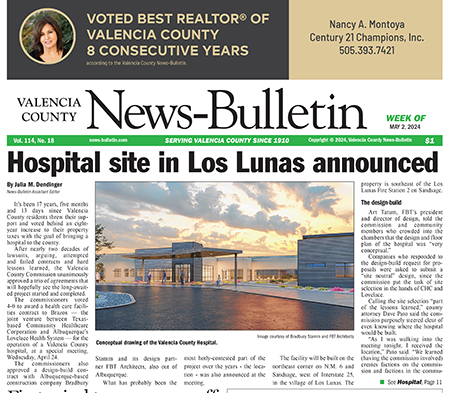In an emergency situation, many people’s first instinct is to call for an ambulance. But what happens if there are none available to send?
In the emergency medical service world, this is a problematic situation called Status Zero, which is on the rise both locally and nationally.
Dr. Whitney Barrett, the medical director for EMS services in Valencia County, says Status Zero is an issue that affects everybody and is one of the biggest challenges agencies are currently trying to navigate.
When people call 911 in Valencia County, dispatchers at Valencia Regional Emergency Communications Center answer the calls and then start dispatching resources, usually local agencies or mutual aid.
At the same time, an ambulance from American Medical Response, the transporting agency, is also dispatched. Ideally, after a local agency stabilizes the patient and does the initial work, AMR staff will take over patient care and transport them to the hospital.
Barrett, who’s also an emergency medicine doctor at the University of New Mexico Hospital in Albuquerque, said a variety of factors including population growth, a population with more complex medical issues and a shortage of EMS staff can lead to Status Zero.
“Whatever ambulances they have that are designated to the county are either on another call or transporting somebody to hospital. The ripple effect is sometimes when a call comes in to dispatch and we don’t have the usual resources to send,” Barrett said. “We get people to the scene to stabilize the patient, but then we are kind of stuck on how to get them to the hospital.”
Tommy Sanchez, the district director for VRECC, says Valencia County sees instances of Status Zero almost daily, with the average being about 30 a month.
Issues unique to Valencia County
While the increase in Status Zero is not exclusive to Valencia County, Barrett says there are some issues that are unique to Valencia County that make the problem particularly challenging.
“Location and population is a challenge. Valencia County is continuing to grow and it’s becoming quite a population center,” she said. “I think as people are leaving Albuquerque, they are going to more rural areas that tend to not have the infrastructure in place locally, as the distance to the nearest hospital is far. The options are either Albuquerque or Soccoro.
“That’s a big endeavor,” Barrett continued. “Transport providers are out of the area for a long time because it takes 30 minutes to get to Albuquerque, and hospitals are congested and turnover time is awhile, so it can easily be an hour and a half or two hours before the transport crew is back to take care of more people.”
AMR does not have a station in the county, so they work through a dispatch system where they are posted in spots throughout the county, typically near fire stations. Barrett said the number of AMR units in the county depends on the time of day, as they aim to have more ambulances available for when they expect to see the highest volumes of calls.
However, Barrett said it’s common in Valencia County for it to get medically busy when they typically shouldn’t be.
“In a lot of places, we see a predictable spike (in emergency calls) around rush hour because of car accidents,” Barrett said. “So usually a spike in the morning and another spike in the evening when people get off work or get back home to find loved ones who aren’t doing well.”
Barrett said they still see those spikes in Valencia County, but there are also random times throughout the day and week where you wouldn’t otherwise expect much activity, which makes it challenging to predict and therefore staff AMR units accordingly.
Difficult decisions
Usually, local fire department personnel are the first on scene to stabilize patients. All fire departments in the county currently have some assortment of medical providers because about 80 percent of the calls they go on are medical calls.
When a Status Zero situation arises, it puts first responders in a difficult position because it has the wrong people solving the problem.
“Once first responders find out an ambulance is not coming, or it will be a really long wait time, they are faced with difficult decisions that include deciding if a patient is in need enough to take it upon themselves to initiate transport,” Barrett said.
If they initiate transport, they know that they are then leaving their community exposed if another big event or fire happens, Barrett said, because providers won’t be there to respond to the next incident should it occur.
“It’s a stressful job already and to add those extra layers of stress and decision making is a tough situation to put them in,” she said.
It puts patients in a difficult situation as well, Barrett said, because sometimes patients will decide it’s taking too long, and they don’t need to go to hospital and decide to stay home.
“They can choose to do so, but ideally many of these patients should go to hospital for further evaluation, but it’s our system that is encouraging people to make decisions for the wrong reasons,” she said. “Those are some of the patients I really worry about.”
Staff shortages
It’s been within the past couple of years particularly that the intensity of Status Zero has been felt in Valencia County and around the nation. Both Barrett and Sanchez said the number of people leaving EMS is a significant factor.
“Across the country, a lot of people are leaving pre-hospital care. There’s not enough providers really to provide care for all the people who need help,” Barrett said.
“The reality is our pre-hospital providers are not compensated very well for the work they do,” she said. “An EMT basic might make $15 to $17 an hour, and all you have to do is drive down the road to see the amount of money you could make doing much less serious work in a much lower stress environment to understand why someone may not want to be an EMT.”
Sanchez said the dispatch center is also feeling the pressure of staffing shortages.
“Nationally, there is about a 42 percent turnover rate right now for dispatchers. Our turnover rate is 46 percent on an annual basis,” Sanchez said. “It’s not an easy job.”
In New Mexico, and in many other states, dispatchers aren’t classified as first responders so they don’t get access to a lot of the mental health treatment and services other public safety workers get.
“They are still classified as clerical, and this is not clerical,” Sanchez said. “They are the first of the first responders.”
Sanchez said the VRECC board recently increased pay rates for dispatchers which is a good start locally,
“But really we need state and federal help to get them reclassified so they can get access to mental health care because that’s critical in this field,” he said. “Once we address that, we can start tackling that retention rate so people actually want to stay and do this.”
Looking to the future
Barrett encourages the public to support EMS providers whenever an opportunity arises to do so.
“There is a lot involved in responding to emergencies. A lot of times I think we take for granted that if we call 911 an ambulance will show up and somebody will take care of you,” she said. “When looking at what our tax money is going to, please keep EMS in mind as an important component and thank an EMS provider when you see them.”
Sanchez said with the county growing at such a fast pace, he predicts the number of total calls received by VRECC will increase by 3 to 4 percent this coming year.
“Last year, we had 170,000 calls; about 123,000 turned into documented incidents. This coming year, we’re trending to handle about 180,000 calls,” Sanchez said.
Barrett said in instances of Status Zero, dispatch frequently reaches out to Isleta EMS or corporate AMR to see if there is an ambulance somewhere they can send down. However, given the current constraints on the system, they are working on finding additional ways to mitigate the problem.
“At the beginning of this year, we started having monthly meetings with local EMS, VRECC and AMR leadership to address some of these issues and discuss ways to be more efficient with resources, especially because they are all shared resources,” Barrett said. “We are all sort of dependent on each other across the county in a lot of ways, so bringing everyone together to think as a group rather than individual agencies is important.”
Barrett said they have so far come up with a list of priorities to work on in the coming months and guidelines for how agencies interact with each other.
“We’re also trying to identify areas for small improvements that might alleviate some pressure currently experienced within the system,” she said. “Everyone is doing their best in trying to meet the needs of the community with the resources at hand.”
Felina Martinez was born and raised in Valencia County. She graduated from the University of New Mexico in 2021. During her time at UNM, she studied interdisciplinary film, digital media and journalism. She covers the village of Los Lunas, Los Lunas Schools, the School of Dreams Academy and the town of Peralta.


















